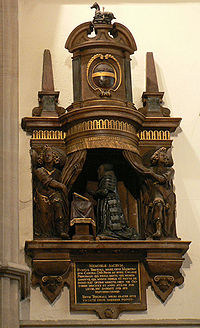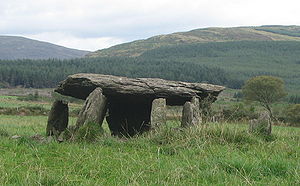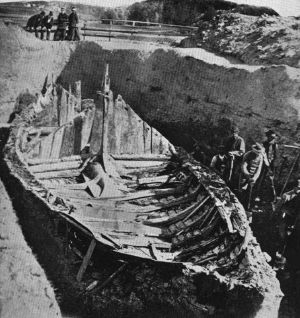Tomb
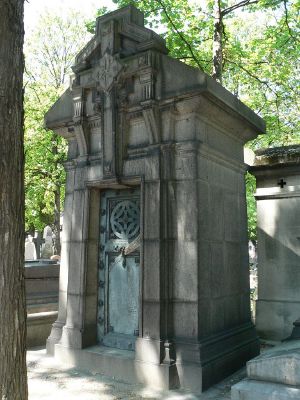
A Tomb is a repository for the remains of the dead. Derived from the Greek tymbos, meaning burial ground, he term generally refers to any structurally enclosed interment space or burial chamber of varying size. Tombs are generally located in or under religious buildings, such as churches, or in cemeteries or churchyards. They may also be found in catacombs, on private land or in open landscape. The tomb of Emperor Nintoku, the 16th emperor of Japan, is the largest tomb in the world by area. However, the Pyramid of Khufu in Egypt is the largest tomb by volume. The term is used in a broad sense to encompass a number of such internments including graves, burial vaults, church monuments, funerary monuments and memorials. Most tombs reflect a system of religious beliefs and ideals, and can be used by archaeologists to determine significant insight into the status and wealth of those buried. Examples of famous tombs include the Taj Mahal at Agra, India, the Dome des Invalides in Paris, and the Lenin mausoleum in Moscow.
History
The earliest church monuments, dating from the early 12th century, were simple stone coffin-shaped grave coverings incised with a cross or similar design. The first attempts at commemorative portraiture emerged soon afterwards, executed in low relief, horizontal but as in life. Gradually these became full high-relief effigies, usually recumbent, as in death, and, by the 14th century, with hands together in prayer. In general, such monumental effigies were carved in stone, marble or wood, or cast in bronze or brass. Often the stone effigies were painted to resemble life, but on the vast majority of medieval monuments, this has long since disappeared. The crossed-legged attitude of numerous mail-armoured knights was long supposed to imply that the deceased had served in the Crusades, but this supposition is unfounded. By the early 13th century, the effigies became raised on tomb-style chests (known as tomb chests or altar tombs) decorated with foliage, heraldry or architectural detailing. Soon such chests also stood alone with varying degrees of decorations. By the end of the century, these often had architectural canopies and figured 'weepers' (often friends or relatives identified by their coats of arms) were popular decorative features. In the 15th century these often became angels or saints and the chest might include a cadaver. The best monuments were made of alabaster. Around the 13th century, smaller two-dimensional effigies incised in plates of brass and affixed to monumental slabs of stone became popular too. These memorial brasses were somewhat cheaper and particularly popular with the emerging middle class.
In the 16th century, church monuments became increasingly influenced by Renaissance forms and detailing (pilasters, wreaths, strapwork, skulls, coffered arches, obelisks, allegorical figures, etc), particularly in France, the Netherlands and, eventually, England. There were major innovations in effigial posture, the deceased often being shown reclining or kneeling in prayer and surrounded by the whole family, as in life. Cadavers were replaced by skeletons. The 'hanging' mural or wall monument also became popular, sometimes with half-length 'demi-figures'; and also the floor-bound heraldic ledger stone. The 17th century saw an increase in classicism and the use of marble. Effigies might be sitting or standing, grief-stricken, shrouded or, unusually, rising from the grave. Busts and relief portraits were popular. High Baroque monuments were some of the grandest ever constructed. Decoration turned to cherubs, urns, drapery, garlands of fruit and flowers. In the 18th century, church monuments became more restrained, placed before two-dimensional pyramids, but more Roman-like, with the deceased often depicted in Roman dress or as a cameo-like 'medallion portrait'. The Rococo style gave more movement to these figures.
The early 19th century brought us Greek Revival monuments, some quite plain wall plaques, some with sentimental and romantically realistic figures (perhaps rising to heaven) or other devices like weeping willows. Gothic Revival followed, with the obvious return to alabaster, tomb chests and recumbent effigies. However, the Victorian age saw many differing styles, until large-scale monuments fell out of fashion at the end of the century. 20th century large-scale monuments are not unknown, but quite rare.
Types of Tombs
Burial Vaults
Burial vaults, made of stone or often brick-lined, are underground spaces for interment, rather than burial. Originally vaulted, burial vaults were often privately owned by family groups and were established beneath a religious building such as a church or kept in a churchyard or cemetery.
Chamber Tomb
A chamber tomb is a tomb for burial used in many different cultures. In the case of individual burials, the chamber is thought to signify a higher status for the interree than a simple grave. Built from rock or sometimes wood, the chambers could also serve as places for storage of the dead from one family or social group and were often used over long periods for the placement of multiple burials. There are numerous terms for them depending on the period, design and region in question. Most were built from large stones or megaliths and covered by cairns, barrows or earth, but the term is also applied to tombs cut directly into rock and wooden-chambered tombs covered with earth barrows. Grave goods are a common characteristic of chamber tomb burials.
In Neolithic and Bronze Age Europe stone-built examples are known by the generic term of megalithic tombs. Chamber tombs are often distinguished by the layout of their chambers and entrances or the shape and material of the structure that covered them, either an earth barrow or stone cairn. A wide variety of local types has been identified, and some designs appear to have influenced others.
Church Monuments
A church monument is an architectural or sculptural memorial to a dead person or persons, often in the form of an effigy or a wall tablet, located within a Christian church. It usually resides immediately above or close to the actual burial vault or grave, although very occasionally the tomb is constructed within it or it is a mere cenotaph. Once only the subject of antiquarian curiosity, church monuments are today recognized as fine works of art, as well as a highly detailed and invaluable record of antique costume and armor and, from the middle of the 15th century, of genuine face-portraiture.
The church monuments of England, in particular, have been preserved in far greater numbers and, generally, in better condition than those of other countries. Fine examples may be found in cathedrals and parish churches in every county, and include Turvey in Bedfordshire, Aldworth, Bisham & St. George's Chapel, Windsor in Berkshire, Chenies & Wing in Buckinghamshireand Bunbury & St. Michael's, Macclesfield in Cheshire.
Mausolea
Mausolea, including the ancient Egyptian pyramids, are external free-standing structures, above ground, acting as both monument and place of interment, usually for individuals or family groups.
Sarcophagi, or stone containers for bodies or coffins, are often decorated and can be a significant part of a monument. Such containers may stand within religious buildings, greater tombs, or mausolea.
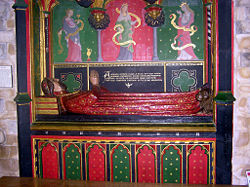
Megalithic Tombs
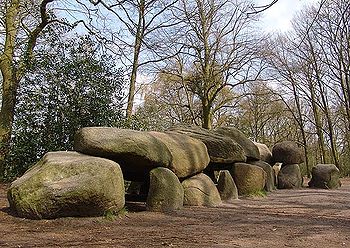
Megalithic tombs, including chamber tombs, are prehistoric places of interment, often used for large communities, constructed of large stones and originally covered with an earthen mound. Such tombs were over ground burial places, built by Neolithic farming communities, from large stone slabs known as megaliths laid on edge. The stones were then covered with earth or other, smaller stones. Megalithic tombs are a type of chamber tomb, and the term is used to describe the structures built across Atlantic Europe, the Mediterranean and neighboring regions, mostly during the Neolithic period. They differ from the contemporary long barrows through their structural use of stone and may contain cremations or articulated or disarticulated inhumations which were kept in the more accessible stone chambers, unlike those simply buried underneath barrows.
There is a huge variety of types and styles. The free-standing single chamber dolmens and portal dolmens found in Brittany, Denmark, Germany, Ireland, Netherlands, Sweden, Wales and elsewhere consist of a large flat stone supported by three, four or more standing stones. They were covered by a stone cairn or earth barrow.
Examples with outer areas, not used for burial are also known, the Court Cairns of south west Scotland and northern Ireland, the Severn-Cotswold tombs of south west England and the Transepted gallery graves of the Loire region in France share many internal features although the links between them are not yet fully understood. That they often have antechambers or forecourts is thought to imply a desire to emphasise a special ritual or physical separation of the dead from the living by the builders.
The Passage graves of Orkney, Ireland's Boyne Valley, and north Wales are even more complex and impressive, with cross shaped arrangements of chambers and passages. The workmanship on the stone blocks at Maeshowe for example is unknown elsewhere in north west Europe at the time.
Megalithic tombs appear to have been used by communities for the long-term deposition of the remains of their dead and some seem to have undergone alteration and enlargement. The organisation and effort required to erect these large stones mean that the societies concerned must have placed great emphasis on the proper treatment of their dead. The ritual significance of the tombs is supported by the presence of megalithic art carved into the stones at some sites. Hearths and deposits of pottery and animal bone found by archaeologists around some tombs also implies some form of burial feast or sacrificial rites took place there.
Further examples of megalithic tombs include the stalled cairn at Midhowe in Orkney and the passage grave at Bryn Celli Ddu on Anglesey. Despite its name, the Stone Tomb in Ukraine was not a tomb but rather a sanctuary.
Sepulchre
Sepulchres are cavernous, rock-cut or stone-built, underground spaces for interment, such as the tombs of Ancient Egypt. However most sepulchre's are generally used to refer to similar Jewish or Christian structures. In ancient Hebrew practice, sepulchres were carved into the rock of a hillside. The term is also used for the sepulchral burial site of Jesus in Jerusalem, over which the Church of the Holy Sepulcher has been erected.
The term sepulchre was first mentioned as purchased by Abraham for Sarah from Ephron the Hittite (Gen. 23:20). This was the "cave of the field of Machpelah", where also Abraham and Rebekah and Jacob and Leah were buried (79:29-32). In Acts 7:16 it is said that Jacob was "laid in the sepulchre that Abraham bought for a sum of money of the sons of Emmor the father of Sychem." It has been proposed, as a mode of reconciling the apparent discrepancy between this verse and Gen. 23:20, to read Acts 7:16 thus: "And they [i.e., our fathers] were carried over into Sychem, and laid in the sepulchre that Abraham bought for a sum of money from the sons of Emmor [the son] of Sychem." In this way the purchase made by Abraham is not to be confounded with the purchase made by Jacob subsequently in the same district. Of this purchase by Abraham there is no direct record in the Old Testament. (See Thomas Campbell)
Tombs of the Hebrews were generally excavated in the solid rock or were natural caves. Mention is made of such tombs in Judges 8:32; 2 Samuel 2:32; and 2 Kings 9:28; 23:30. They were sometimes made in gardens (2 Kings 21:26; 23:16; Matthew 27:60). They are found in great numbers in and around Jerusalem and all over the land. They were sometimes whitewashed (Matthew 23:27, 29). The body of Jesus was laid in Joseph of Arimathea's new rock-hewn tomb, in a garden near to Calvary perhaps the site of the Holy Sepulchre.
The mouth of such rocky tombs was usually closed by a large stone (Hebrew golal), which could only be removed by the united efforts of several men (Matthew 28:2; John 11:39)
Ship Burial
A ship burial or boat grave is a burial in which a ship or boat is used either as a container for the dead and the grave goods, or as a part of the grave goods itself. If the ship is very small, it is called a boat grave. This style of burial was used in the Vendel era and by the Anglo Saxons, the Merovingians, the Vikings and occasionally the Ancient Egyptians. This burial was seen as a way for the dead to sail to Valhalla, ship burial was a high honor. Some examples of ship burials include the Khufu ship Giza pyramid complex, the Sutton Hoo of East Anglia, England, and the Tune of Norway.
ReferencesISBN links support NWE through referral fees
- Ibmmissc. Easton's Bible Dictionary. The Ellis Bible Study Series. 1897. ISBN 0933186592.
- Crossley, Fred. English Church Monuments: AD 1150-1550. B.T. Batsford Publishing. 1921.
- Esdaile, Katherine. English Church Monuments 1510-1840. B. T. Batsford Publishing. 1946.
- Kemp, Brian. English Church Monuments. B.T. Batsford Publishing. 1980. ISBN 0713417358.
- Nelson, Sarah. The Archaeology of Korea. Cambridge University Press, Cambridge. 1993. ISBN 0521407834.
- Oxford University Press. Tomb. Archeology Dictionary. Retrieved 4 June 2007.
- Britannica Concise Encyclopedia. Tomb. Encyclopedia Britannica. Retrieved 4 June 2007.
- Columbia University Press. Tomb. Columbia Electronic Encyclopedia. Retrieved 4 June 2007.
External Links
- The Church Monuments Society
- Royal Berkshire History: Church Monuments
- Churchmouse: Church Monuments & Other Memorials of Interest
Credits
New World Encyclopedia writers and editors rewrote and completed the Wikipedia article in accordance with New World Encyclopedia standards. This article abides by terms of the Creative Commons CC-by-sa 3.0 License (CC-by-sa), which may be used and disseminated with proper attribution. Credit is due under the terms of this license that can reference both the New World Encyclopedia contributors and the selfless volunteer contributors of the Wikimedia Foundation. To cite this article click here for a list of acceptable citing formats.The history of earlier contributions by wikipedians is accessible to researchers here:
- Tomb history
- Burial_vault_(tomb) history
- Church_monument history
- Megalithic_tomb history
- Sepulchre history
- Chamber_tomb history
- Ship_burial history
The history of this article since it was imported to New World Encyclopedia:
Note: Some restrictions may apply to use of individual images which are separately licensed.
